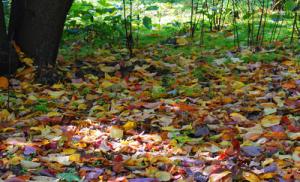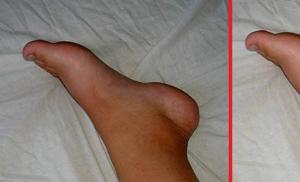Mixed and deciduous forests. Mixed broadleaf forest zone
Geographical position natural forest areas
Broad-leaved forests are common in areas that are characterized by the optimal ratio of humidity and heat:
- temperate Europe,
- Far East,
- Menchuria,
- Eastern regions of China,
- Japan,
- North America.
On South South America and in Central Asia there are small areas of deciduous forests.
In Russia, broad-leaved forests occupy an area that looks like a triangle, the top of which rests on Ural mountains, and the base is located at the western border of the country. AT Quaternary given territory has been repeatedly covered continental ice, so it has mostly hilly terrain. Clear traces of the Valdai glacier can be found in the northwest of the country, where the zone of mixed and deciduous forests characterized by a disorderly heap of steep ridges, hills, basins and closed lakes. In the south of the territory there are secondary moraine plains, formed as a result of the decrease in the sloping surface of hilly areas.
AT Western Siberia the taiga is separated from the forest-steppe by a narrow strip of aspen and birch forests.
Remark 1
In the relief of broad-leaved and mixed forests meet different area sandy plains, water-glacial origin. They are undulating, you can meet sand dunes.
Climatic conditions and soils of broad-leaved forests
The main condition for the development of an ecosystem of broad-leaved forests is the complex interaction of climate, water, topography and soil features. The climate is moderately warm with mild winters and long warm summers.
The average annual rainfall exceeds the level of evaporation, which reduces the degree of waterlogging of soils.
Remark 2
characteristic feature is the light regime: the first light maximum is observed in spring, when the trees are not yet covered with foliage; the second light maximum appears in autumn, with a period of leaf fall.
Trees protect from excessive winter evaporation: thick bark of branches and trunks, the presence of dense, resinous, scaly buds, leaves falling in autumn.
Organic residues of plants form humus, favor the formation of various organo-mineral compounds, which are based on calcium, silicon, potassium and ash. In smaller quantities they contain phosphorus, aluminum, magnesium, iron, manganese, sodium and chlorine.
On the composition of the soil, a strong blow is caused by a stable snow cover during the melting of snow.
The following types of soils are found in deciduous forests:
- sod-podgolden,
- brown,
- gray,
- varieties of black soil.
Species composition of deciduous forests
The main tree species of broad-leaved forests include: elm, oak, maple, linden, beech, ash, hornbeam, wild pears and apple trees. Oaks and ash trees are the most tall trees, a little lower - lindens, elms, maples, the lowest - wild pears and apple trees, field maples.
The most common representatives of dendroflora:
- Oak. One of the largest and longest growing trees. As a rule, they are the most among other trees.
- Elm. Rough and smooth species are found in the forests of non-chernozem zones. Large trees represent the main layer of broad-leaved and coniferous-broad-leaved forests.
- Common ash. tall plant(30-40 m in height) with a straight trunk, light gray bark and an openwork, loose crown. Heat and light-loving plant. Very picky about the composition of the soil. This is the main plant of field protection cultivation.
- Forest beech. Tree with light gray bark and elliptical leaves, can reach up to 40 m in height and 1.5 m in diameter. Most common in the Caucasus Western Europe and in the Crimea.
- Maple. Grows up to 20 m in height. A tree with large, five-lobed, dark green leaves. Most often found in the forests of the European part of Russia and the Caucasus.
Most forests are multi-tiered systems: herbaceous plants, shrub undergrowth, high tree layer.
The ground layer is formed by mosses and lichens.
Grasses of deciduous forests are characterized by wide and large sheet plates, which is why they got the name "broad grass oak forests". Often grasses cover large areas like a carpet. Among them are: hairy sedge, common gout, yellow Zelenchuk.
Most herbs are perennial plants that can live up to several decades. They reproduce mainly vegetatively, have long underground and ground shoots that grow intensively in all directions.
There are forests in which there is no herbaceous cover and undergrowth due to the presence of dense and high tree crowns. The soil in them is covered with a dense layer of old leaves.
In autumn, the above-ground part of most of the broad grass dies off. Only rhizomes and roots that are in the soil hibernate.
Of the shrubs, lingonberries and blueberries are common.
Oak ephemeroids include: ranunculus anemone, spring chistyak, goose onion, different kind corydalis. These are small but rapidly developing plants that appear immediately after the snow melts. They develop most intensively in spring, in summer the aerial part dies off.
Remark 3
Ephemeroids are perennial plants, their underground roots are represented by rhizomes, bulbs, tubers.
Animal world of deciduous forests
The main representatives of deciduous forests are predators, ungulates, rodents, insectivores and bats.
Most striking species diversity areas untouched by human activity. Wild boars, roe deer, fallow deer, elks, deer, wolves, foxes, ermines, martens, weasels, squirrels, beavers, nutrias and muskrats are common in broad-leaved forests. Many small animals: rats, mice, hedgehogs, moles, snakes, shrews, marsh turtles and lizards.
In the recent past, bison were found in broad-leaved forests. Today, only a few dozen remain. They can be found in Belarus in Belovezhskaya Pushcha, in Russia in the Prioksko-Terrasny Reserve, in Poland and in some countries of Western Europe.
Among the most common birds are finches, larks, tits, warblers, swallows, flycatchers, starlings, rooks, crows, woodpeckers, black grouse, hazel grouses, crossbills, jackdaws. Predator birds deciduous forests: owls, hawks, eagle owls, owls, harriers. Cranes, waders, gulls, herons, geese and ducks live in marshy areas.
South of the taiga zone in temperate continental and continental climate mixed and broad-leaved forests are widespread. Unlike the tundra and taiga, which stretch from the western to the eastern borders of the country, this zone is not a continuous strip. Mixed forests occupy the central part of the East European Plain and the south of Western Siberia. Broad-leaved forests are represented in the European part of Russia, as well as in the south of the Far
East, where they are called "Ussuri taiga".
Most of the zone of mixed and broad-leaved forests is located
lies in a temperate continental climate, which is characterized by a rather warm and longer, compared to the taiga, summer and less Cold winter. Average temperatures in July are + 16...+20 °С, and in January -8...-16 °С. The average annual precipitation (500-600 mm) slightly exceeds the evaporation rate. In the south of the zone, in broad-leaved forests, summers are warmer and longer, therefore, evaporation is higher, the moisture coefficient approaches 1. In general, the zone of mixed and broad-leaved forests is characterized by a milder climate compared to the taiga zone. The species composition of vegetation (both trees and grasses) is much richer than in the taiga. There are both coniferous (spruce, pine) and broad-leaved (oak, linden, maple, etc.) tree species. At the same time, there are more conifers in the north of the zone, closer to the taiga, and broad-leaved species - in the south, closer to the steppes. The distribution of trees is determined not only by climatic conditions, but
and mechanical composition of soils. Light sandy soils are most favorable for pine, heavy loam - for spruce. Oak "prefers" carbonate soils. In place of cut down forests, secondary forests of small-leaved species - birch and aspen - appear. In contrast to the taiga, in mixed and especially broad-leaved forests, layering is clearly visible. There are many shrubs (hazel, bird cherry, honeysuckle, elder, euonymus) and herbs.
(lungwort, lily of the valley, hoof, bell, etc.).
Soil formation conditions, primarily climate and vegetation,
are not the same in the north and south of the zone, which leads to the formation of different
soil types. Sod-podzolic forests are developed under mixed forests, and under
broad-leaved - gray forest soils. They differ in their
structure, thickness of the humus horizon, humus content, and hence
and fertility. The highest natural fertility among forest soils
characteristic of gray forest soils.
Animal world. A diverse food base determined the species richness
nature of the animal world. Of the ungulates here, in addition to the elk, we meet
are Noble deer, roe deer, wild boar and bison (in reserves). From predator
kov - fox, wolf, Brown bear, black ferret, weasel, marten. In forests
many birds, especially songbirds. However, in winter their numbers and species composition
are significantly reduced.
Many species of animals in the zone of mixed and broad-leaved forests on
walk on the edge complete disappearance, the number of others is falling. In Este
natural form animal world zone was preserved only in reserves.
Subzone of mixed forests lies to the south. Starting at the west
de European part of the Union in a wide strip, she, gradually
narrowing, it reaches the Urals. AT mixed forests along with needles
ny and small-leaved species broad-leaved grow -
linden, oak, maple, elm. Beautiful mixed forests! At various times
change of year they become either bright green or golden yellow
tymi or crimson.
The mixed forest subzone has a milder climate and longer summers.
her than in the taiga. Therefore, it is possible to grow here widely.
number of tree species.
The number of broad-leaved species decreases towards the east.
Beech and hornbeam are widespread in the southwest. East
35° E on the East European Plain they no longer meet
Linden. Beyond the Urals, due to the continentality of the climate, disappear along
last broad-leaved trees; from hardwood remain without
cut and aspen.
Broad-leaved species reappear only in the south
Far East. Here, in humid summer conditions, the plant
ness is very rich, differing from the European one in its
ladies. Grow various maples, Mongolian oak, Amur linden
with bright yellow, larger than that of ordinary linden,
flowers, Manchurian walnut, velvet tree, so called
for its light gray, velvety to the touch bark, black bere
behind with dark brown birch bark; some trees give a beautiful,
valuable ornamental wood for various products.
natural conditions forest zone are very favorable for life
not many animals. Here they are provided with abundant food,
especially the seeds of coniferous trees obtained from ked cones
ra, pine, larch, spruce. Hunters often find
eat pine nuts stored for the winter by taiga rodents
(squirrel, chipmunk) and some birds (nutcracker).
Many animals are adapted
got together to climb
tree lamas, such as lynx.
Like on the ground, they run on de
revyam squirrel, chipmunk (Fig.
35), sable.
In addition to them, an elk lives, which chooses marshy areas in summer.
places and forest riverbanks, and in winter - dry watersheds. all over
In the taiga there are bears, foxes, and ferrets (Fig. 36). Highly
many birds nesting in trees. Animals and birds
living in the forest, have a protective color to match the color of the soil, stem
fishing for trees, fallen leaves, greenery.
In the forest zone, especially in the taiga, hunting and breeding are developed.
in special farms of fur-bearing animals.
The natural zone of mixed and broad-leaved forests occupies a smaller area than coniferous forests. However, this complex, formed under conditions of sufficiently warm and humid climate, has a great variety of flora and fauna.
Characteristics of the natural zone Mixed forests
Mixed forests are a transitional link between the taiga zone and broad-leaved forests. The name of the natural area speaks for itself: both conifers trees and deciduous. Mixed forests are found on the territory of Russia and the European region, South and North America, New Zealand.
The climate of this natural complex pretty soft. In winter, the temperature drops to -15 degrees Celsius, and in summer it fluctuates between + 17-24.
Compared to the taiga, summer is warmer and longer. Number of annual precipitation exceeds evaporation, which was the impetus for the emergence of deciduous trees.
A distinctive feature of mixed forests is a well-developed grass cover growing on soddy-podzolic soils.

Rice. 1. The grass cover is very developed in the zone of mixed forests.
This natural zone is characterized by a pronounced layering - a change in the type of vegetation depending on the height:
- the highest tier of coniferous-deciduous forests are mighty oaks, pine and spruce;
- below are lindens, birches, wild apple trees and pears;
- further grow the lowest trees: viburnum, mountain ash;
- below are raspberry, hawthorn, wild rose bushes;
- the layering of mixed forests is completed by a variety of grasses, mosses and lichens.
The fauna of mixed forests is also diverse. Here live large herbivores (moose, wild boars, deer and roe deer), rodents (beavers, mice, ferrets, squirrels), predators (foxes, wolves, lynxes).
TOP 3 articleswho read along with this

Rice. 2. Lynx - typical representative forest predators.
Description of the broadleaf forest zone
When moving south of the mainland, they change climatic conditions, which leads to the change of mixed forests to broad-leaved ones. As a result, coniferous trees become much smaller, and dominance completely passes to deciduous species.
Broad-leaved forests are characterized by a rather warm climate with mild winters and long warm summers. The amount of annual atmospheric precipitation slightly exceeds evaporation, due to which waterlogged soils are a rarity for these territories.
Typical tree species for this zone are maple, linden, oak, beech, ash.
In dense thickets of broad-leaved forests, dense crowns of trees do not allow the grass cover to fully develop. The ground in such areas is covered with a layer of fallen leaves. Decaying, it contributes to the formation of humus and the enrichment of gray and brown forest soils.

Rice. 3. In the zone of deciduous forests coniferous trees- a rarity.
The fauna of deciduous forests is no different from the zone of mixed forests. However, as a result of active human activity, the number of wild animals has significantly decreased, and at present they live only in nature reserves or in remote areas.

Climate Mixed forests are characterized by warm summers and relatively cold and long winters. The annual amount of atmospheric precipitation up to mm. Moisture coefficient in mixed forests is usually slightly higher than unity, but varies quite a lot from year to year.

Soils In the north, under coniferous-deciduous forests, soddy-podzolic soils are common, and in the southern part, under broad-leaved forests, gray forest soils. There are 3 main horizons: the upper humus (the most fertile), the horizon of leaching and leaching.

Vegetation Vegetable world broad-leaved and mixed forests is diverse. Spruces, pines, lindens, maples, birches and aspens. Shrubs grow under the trees: hazel, euonymus, elderberry, raspberry, buckthorn, viburnum, and under them - an abundance of herbs. Moss grows only in damp, dark places. In such fertile forests there are always a lot of mushrooms and all kinds of delicacies from berries. There are many light-loving berry plants: strawberries, raspberries, stone fruits, blueberries.

Wildlife In the zone of mixed and broad-leaved forests there are the following animals: white hare, elk, squirrel, flying squirrel, capercaillie. Of the birds, insectivorous and granivorous predominate here. And also live: forest cat, brown bear, pine marten, black ferret, mink, weasel, squirrel.


07.05.2016 15:30
Illustration:
Broad-leaved forests are located on the Russian Plain, occupying almost the entire territory up to the Urals. The wealth of these massifs is determined by the variety of tree and plant species growing here. Surprisingly, it is these forests that are most common in most regions of our country due to their adaptability to rapidly changing conditions. weather conditions and temperature conditions.
Only the broad-leaved forests of our country require a special climate for their full development and expansion of forest areas. They grow even in the south of the Far East, along the entire length of the climatic zone.
Certain tree species that can grow on the borders of various forests help to distinguish between different forest areas. natural areas, whose climate often changes very frequently. For example, such a breed is spruce. It seems to draw the line between mixed and broad-leaved forests.
Another way to distinguish forests from each other is to study what types of trees grow in them. Broad-leaved forests are characterized by deciduous varieties of trees, the leaves of which can fall depending on the season and temperature. Leaves are also involved in the processes of photosynthesis, recycle carbon dioxide present in nature into oxygen that is favorable for life.
Forest-steppes also represent a certain boundary between forests. Trees practically do not grow in these territories, and the soil, due to the presence of special nutritional components, is colored in dark colors and shades.
Features of broad-leaved forests in Russia
Often on the territory of deciduous forests grow trees that belong to deciduous species. Sometimes there are other breeds. But if they are here in small quantities and do not exceed the total volume deciduous trees, - to mixed type this forest is not included.
Here you can find gray forest soil, which provides the trees with all the useful substances necessary for their life. The remaining components of the trees are taken from their own leaves in the autumn-winter seasons of the year. When the leaves turn yellow and fall off, the trunk and root system of the tree prepares to overwinter, to “wait out” the times unfavorable for its growth.
But if the trunk is protected by bark, then the root system is more vulnerable in this regard. After all, the soil cools down in winter due to lack of sun rays. Then the situation is saved by fallen leaves. They rot and nourish the roots and trunk of trees that are in a state of "sleep".
Such natural processes as leaf rotting are able to maintain a certain constant temperature in certain areas of the soil, so tree:
- completely protected from the cold
- does not lose its ability to further growth,
- saves useful substances in order to use them in the spring, when climatic conditions again become favorable for broad-leaved trees.
In the east of the most extensive forest area, the heat supply is much higher than in the zone of mixed forests closest to it. Therefore, trees fully grow and develop here, much faster.
Rich vegetation of deciduous forests
Since the soils are rich in all the components necessary for the growth of trees and all kinds of plants, the vegetation of these places is quite diverse. After all, the period of its growth and development increases due to temperate climate and low temperatures. However, in the spring, a decrease in humidity can be seen in some areas of broadleaf forests. Therefore, if we consider this array from a bird's eye view, we can see that its integrity is slightly certain places"voids" not filled with trees are visible. As mentioned above, the reasons for this natural phenomenon there may be several.
AT recent times broad-leaved forests have significantly reduced the volume of their territories. This is because technological progress is developing at such a speed that forests simply do not have time to restore their arrays.
The forest needs help
Broadleaf forests really need human help. No matter how paradoxical it sounds, but only he is able to reduce the destructive impact on nature.
- to plant seedlings in those places where forest areas are interrupted for any reason,
- to ensure the protection of broad-leaved and other types of forests from encroachments by poachers and irresponsible entrepreneurs who mercilessly cut down large areas this natural material
- create all conditions for buildings and cities to be at a certain distance from the forest.
All these conditions are not easy to comply with, since many of them are practically not controlled by the state. Industrial enterprises emit too many emissions into our atmosphere. Only forests can help clean the air. Therefore, their preservation is so important for the future of our planet.
Broad-leaved forests, like other forests, are the lungs of the Earth. Without forests, our planet would not be able to exist in the form in which it functions and develops now.
Everything you need to keep environmental health planets - protection of forests. This is not so difficult, given that only in our country broad-leaved forests grow, which have practically no analogues in the world in terms of the length of their arrays. Since such wealth grows in one territory, it simply needs to be preserved.
Broadleaf forests and industry
Surprisingly, these massifs are the main raw material in the timber industry. They are a versatile material for processing, which is able to restore its resources.
In industry, even production waste is used. I.e, recycling already processed raw materials in our country is established. But at the same time, the volume of deforestation is not reduced. To remedy this situation, a complete reorganization of the enterprises involved in this stage of work with wood processing should be carried out.
Broadleaf forest potential
Due to the fact that the data forest areas there is an active biological cycle of all natural elements, the soil is constantly "working", renewing its natural potential.
In addition, thanks to such metamorphoses, broad-leaved forests are cleansed of all kinds of pollutants that have settled on the leaves and branches of harmful chemical elements.
Thanks to the vital activity of all microorganisms, plants and animals present in the area, the composition of calcium in the soil is updated, which is simply necessary for the growth of trees.
In the earth, thus, accumulate:
- tree-friendly fertilizers,
- mineral substances that ensure the expansion of the boundaries of the forest,
- humus that supports everything chemical processes and reactions in the soil at an optimal level for tree life.
Sometimes in the broad-leaved forests of our country, in certain climatic zones, you can meet black soil. Thanks to him, trees grow much faster, and the flora and fauna of these areas is very rich and diverse.
Animals in similar forests live mainly herbivores. After all, the leaves of some trees are the main "dish" for many ungulates. In broad-leaved forests, you can meet deer or roe deer. The wild boar is very adapted to such places, feeding on oak acorns and other fruits that fall at the moment of one of the stages of tree growth.
In fact, the fauna of these forests is quite rich, but the same type due to the climate. AT winter periods time, some birds fly south due to the lack of food necessary for their life, and animals hibernate or look for alternative sources to get food.
On the Russian plain, a certain anthropogenic transformation is observed, which broad-leaved forests have undergone. Oak forests have practically disappeared, which for several centuries adorned most of the territory of the plain up to the Urals.
Most of the soils on which it grew were cultivated and plowed up. Frequent exploitation of soils useful with various mineral fertilizers and other nutrients for trees has reduced their natural potential. It will take decades to restore its resources and expand broadleaf forests.
And all that a person had to do was to use the resources already available in nature reasonably, not to cut down forests thoughtlessly, as if they were eternal, but such natural resources unlimited on earth.
What has already been done cannot be changed, it remains only to try to correct this trend in the reduction of broad-leaved forests in our country. To do this, it is not necessary to plant new trees on plots of land already used for industrial purposes. You can do otherwise and save the remaining forest areas.
Broad-leaved forests in our time represent a unique ecosystem capable of self-healing. It is possible to carry out the development of natural resources on its territory only if it is organized correctly.
To do this, experts determine which of the trees can be classified as suitable for felling, and which cannot be touched due to their age and ability to create new trees.
Next, the trees are marked, and the process of cutting down and harvesting wood begins. It must be carried out at a certain time of the year so as not to disturb natural processes flowing in trees. After cutting down, a break is made and observation of broadleaf forest. If this site is gradually restored, then it is possible to start selective felling on another one. Complete deforestation is prohibited due to the fact that young trees are sometimes cut down along with trees suitable for processing. Due to their potential, the territories of broad-leaved forests are expanding.
If you give nature time, then the humus layer in the soil will return to its previous level again. After all, the growth rate of broad-leaved trees and their further development depend on this. Therefore, the protection of forests is now the main issue on which not only the development of the Russian forest industry, but also the health of our planet as a whole depends.













